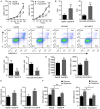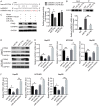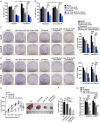MiR-374b re-sensitizes hepatocellular carcinoma cells to sorafenib therapy by antagonizing PKM2-mediated glycolysis pathway
- PMID: 31106002
- PMCID: PMC6511640
MiR-374b re-sensitizes hepatocellular carcinoma cells to sorafenib therapy by antagonizing PKM2-mediated glycolysis pathway
Abstract
Despite impressively initial clinical responses, the majority of hepatocellular carcinoma (HCC) patients treated with sorafenib eventually develop resistance to this drug. It is well-known that microRNA (miRNA) plays a critical role in HCC progression and sorafenib resistance. However, the potential mechanism by which miRNA contributes to the human HCC cells to sorafenib resistance is still unknown. Herein, we identify miR-374b/hnRNPA1/PKM2 axis serving as an important mechanism for acquired sorafenib resistance of HCC cells. By establishing a sorafenib-resistant HCC model, we demonstrated that miR-374b reduces the expression of hnRNPA1 by binding to its 3' untranslated region, which subsequently decreases levels of PKM2. The suppression of PKM2 by miR-374b re-sensitizes sorafenib-resistant HCC cells and mouse xenografts to sorafenib treatment by antagonizing glycolysis pathway. Clinically, hnRNPA1 and PKM2 expression are upregulated and inversely associated with miR-374b expression level in sorafenib-resistant HCC patients. Moreover, sorafenib significantly induces the expression of hnRNPA1, which serves as an important mechanism for the acquired sorafenib resistance in HCCs. Thus, our data suggest that targeting the alternative splicing of the PKM by miR-374b overexpression may have significant implications in overcoming the resistance to sorafenib therapy.
Keywords: MiR-374b; PKM2; hepatocellular carcinoma; hnRNPA1; sorafenib.
Conflict of interest statement
None.
Figures






Similar articles
-
Endoplasmic reticulum stress promotes sorafenib resistance via miR-188-5p/hnRNPA2B1-mediated upregulation of PKM2 in hepatocellular carcinoma.Mol Ther Nucleic Acids. 2021 Oct 1;26:1051-1065. doi: 10.1016/j.omtn.2021.09.014. eCollection 2021 Dec 3. Mol Ther Nucleic Acids. 2021. PMID: 34786210 Free PMC article.
-
Dauricine upregulates the chemosensitivity of hepatocellular carcinoma cells: Role of repressing glycolysis via miR-199a:HK2/PKM2 modulation.Food Chem Toxicol. 2018 Nov;121:156-165. doi: 10.1016/j.fct.2018.08.030. Epub 2018 Aug 29. Food Chem Toxicol. 2018. PMID: 30171973
-
LncRNA MAGI2-AS3 inhibits hepatocellular carcinoma cell proliferation and migration by targeting the miR-374b-5p/SMG1 signaling pathway.J Cell Physiol. 2019 Aug;234(10):18825-18836. doi: 10.1002/jcp.28521. Epub 2019 Mar 28. J Cell Physiol. 2019. PMID: 30924168
-
MiR-21 mediates sorafenib resistance of hepatocellular carcinoma cells by inhibiting autophagy via the PTEN/Akt pathway.Oncotarget. 2015 Oct 6;6(30):28867-81. doi: 10.18632/oncotarget.4814. Oncotarget. 2015. PMID: 26311740 Free PMC article.
-
The role of microRNA in the resistance to treatment of hepatocellular carcinoma.Ann Transl Med. 2019 Oct;7(20):577. doi: 10.21037/atm.2019.09.142. Ann Transl Med. 2019. PMID: 31807558 Free PMC article. Review.
Cited by
-
AKR1C3-dependent lipid droplet formation confers hepatocellular carcinoma cell adaptability to targeted therapy.Theranostics. 2022 Nov 7;12(18):7681-7698. doi: 10.7150/thno.74974. eCollection 2022. Theranostics. 2022. PMID: 36451864 Free PMC article.
-
Sam68 promotes aerobic glycolysis in colorectal cancer by regulating PKM2 alternative splicing.Ann Transl Med. 2020 Apr;8(7):459. doi: 10.21037/atm.2020.03.108. Ann Transl Med. 2020. PMID: 32395503 Free PMC article.
-
Sex differences in disease: sex chromosome and immunity.J Transl Med. 2024 Dec 27;22(1):1150. doi: 10.1186/s12967-024-05990-2. J Transl Med. 2024. PMID: 39731171 Free PMC article. Review.
-
Ferroptosis rewired: ncRNA gatekeepers as pharmacological targets in hepatocellular carcinoma.Naunyn Schmiedebergs Arch Pharmacol. 2025 Jul 7. doi: 10.1007/s00210-025-04404-4. Online ahead of print. Naunyn Schmiedebergs Arch Pharmacol. 2025. PMID: 40622592 Review.
-
MicroRNAs in Hepatocellular Carcinoma Pathogenesis: Insights into Mechanisms and Therapeutic Opportunities.Int J Mol Sci. 2024 Aug 29;25(17):9393. doi: 10.3390/ijms25179393. Int J Mol Sci. 2024. PMID: 39273339 Free PMC article. Review.
References
-
- Rimassa L, Abbadessa G, Personeni N, Porta C, Borbath I, Daniele B, Salvagni S, Van Laethem JL, Van Vlierberghe H, Trojan J. Tumor and circulating biomarkers in patients with second-line hepatocellular carcinoma from the randomized phase II study with tivantinib. Oncotarget. 2016;7:72622. - PMC - PubMed
LinkOut - more resources
Full Text Sources
Miscellaneous
